#overhauling of boiler
Text

Boilers and chillers Erection manufacturer and supplier
We have decades of experience servicing boilers and chillers for multiple commercial and industrial facilities as well as servicing other mechanical, electrical and plumbing systems.we provide Magnetic bearing chillers,Screw & scroll chillers,Reciprocating chillers,Steam & hot water boilers,Reciprocating chillers,Steam & hot water boilers,Chiller & boiler controls, System pumps and Cooling tower.
For more details, please visit our website -
#manufacturer#supplier#india#erection#boiler#repairing of boiler#pressure parts.#overhauling of boiler#auxiliaries
0 notes
Text
Flying Scotsman in 2004 - A Comedy of Errors and Owners:
Ok - so this is something I've been sitting on for a while now, but I feel like with 'The World Famous Engine' now being uploaded to Ao3, now is the right time to cover this rather insane topic. See, we all know the story of Flying Scotsman and the NRM: the NRM bought the engine for the nation, and then sent it into the Works for 1 years' worth of work in 2006... One year of work that ended up spiralling into ten years and £4.2 million.
But behind that story is a rather more shocking story, and one that really needs more recognition to help people understand just how absolutely shockingly Flying Scotsman had been treated before that overhaul.

Sir William McAlpine:
Our story most likely begins under Alan Peglar, but I have a rather sneaking suspicion it actually gets interesting under McAlpine. Sir William McAlpine bought 4472 Flying Scotsman in 1972 to save the engine after Alan Peglar went bankrupt in San Francisco, leaving the engine on a US Military Base.
He brought Scotsman and had the engine restored at Derby Works in England, and then successfully owned and ran the engine for another 23 years, making him the longest-lasting and most successful of all Scotsman's owners.
Pretty good achievement!
But, during this era, Flying Scotsman visited Australia, broke the record for the longest non-stop run by a steam locomotive, pulled the Royal Train, ran on a multitude of heritage railways and mainline excursions, got an overhaul three times - including one at Barrow-in-Furness (story idea, anyone?). This is not where the worst of the issues arose from, but it does give you a good idea of the kind of work this engine was being tasked with.
And then in 1995, it was involved in an accident at Llangollen Railway. When put back into steam, smoke emerged from a crack separating the boiler and the front cab. It was deemed a total failure and immediately withdrawn from service immediately - and that's what did McAlpine in. He sold the engine off to cover some debts, and Tony Marchington
What do I think went wrong here? I have a feeling that Scotsman was run pretty haggard in Australia (which, fair - it's not always a very nice country to machines) and when refitted to his BR livery, several... shortcuts were made to get the engine back in service. All the same, this isn't where the trouble came from.
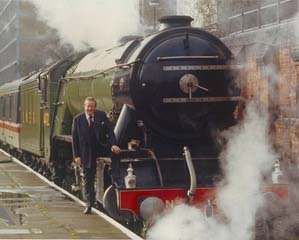
Tony Marchington:
And here's where things went south. Fast. Flying Scotsman was bought, went through a three-year long overhaul worth £1 million and then was set to work. Thing is, that overhaul had a number of red flags surrounding it - perhaps most notable being the fitting of an A4 boiler working at 250psi. Now, for those unaware - the original A1 class ran at 180psi, and the upgraded A3 class ran at 225psi. The engine was being run at a pressure it was extremely unfit to operate with.
It would be a bit like fitting a massive V12 motor to a Honda Accord. Yes, the car will move extremely fast and look impressive and move for a while, but every other piece of that car will deteriorate rapidly due to the pressure it's all under. Now transfer that to a steam locomotive - one where to reach that pressure, the firebox is under a lot of strain.
Flying Scotsman failed a lot during the Marchington era, and it's not surprising why. The poor engine was literally falling to pieces - as one NRM staffmember noted: "On our first inspection, the rear drivers had been removed to deal with bearing problems. The visiting NRM team was most unimpressed with the quality of work being done on the bearings. Other examples of poor workmanship (of which I cannot remember the detail) were evident on inspection.”
Please note, the bearings and valves had all recently been replaced.
Also note, Tony Marchington was under pressure from the shareholders of Flying Scotsman PLC - a company he set up - to make money, and so many of the fitters working on the engine may have been given far, far too many constraints in time and budget to properly overhaul the engine, in essence needing to just 'do the bare minimum to get it back in service'...
And this is the condition the NRM bought 4472 Flying Scotsman in.
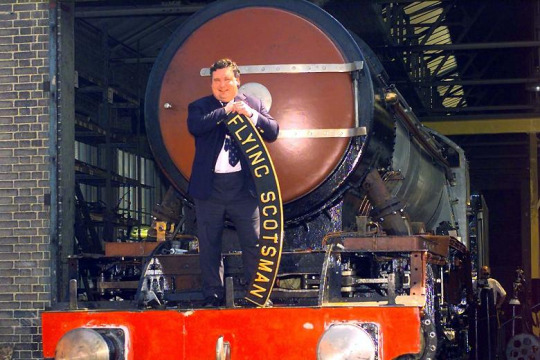
The National Railway Museum:
All of the above is an indication of the condition that Flying Scotsman was in when bought in 2004 - but that only tells about half of the story. The other half is a bunch of issues surrounding the purchase, certification and understanding of just how bad things were. And make no mistake, the NRM is not blameless in this circus - it just managed to inherit a bad situation and then fumble with it until they sat down and figured out what had happened.
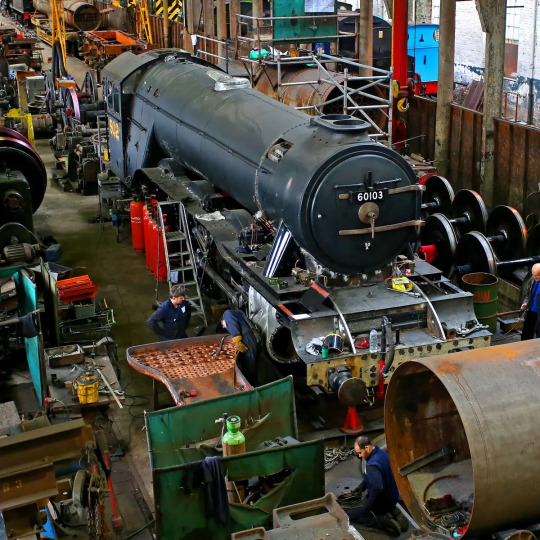
Let's take a moment to look at the AEAT report that the NRM got, then compare it to reality:
The AEAT report stated that:
"Whilst it was not possible to complete a thorough examination of the locomotive, or to witness it in steam, the condition of the locomotive has been monitored regularly as part of the VAB audit process. Taking this into consideration, it is considered that the general mechanical condition is satisfactory for continued operation, subject to effective maintenance, until the next General Overhaul in 2006. The scope of mechanical overhaul is not anticipated to be extensive but will involve strip down of the motion and axleboxes to gauge wear and remedial action. The cylinders all require re-lining and boring to nominal diameter."
The reality of the condition of the engine was far from this rather rosy portrayal given by AEAT. For starters, the engine was not properly examined, and several areas of testing were 'not possibly to be checked adequately' for a variety of reasons, including:
the locomotive was being prepared for a test run
equipment failure
4472 Flying Scotsman not being in steam
Anyone notice something off? Why exactly can the company not see how the engine is when in steam if the engine is being prepared for a test run?

Furthermore, AEAT had been the VAB (Vehicle Acceptance Body) for Flying Scotsman for 14 years by this point and finding a huge number of faults at this point very much would have raised questions about their work. More probably, the company had grown accustomed to the engine working, and simply assumed everything was satisfactory unless demonstratable to the contrary. Like the NRM admitted:
"[T]he previous owner’s VAB may not have been the best choice of inspector."
Thing is, AEAT included pictures in their report, but most of these were of the air brake compressor, locomotive air brake, tender air brake cylinders, TPWS antenna selection switch and the TPWS antenna mounting arrangements, which while critical to obtaining permission to operate on Network Rail, don't say much about the actual condition of the engine. And the photos that were of the actual mechanical parts of the engine were... telling.

The Stay Nuts in the firebox are rusting, melting and missing. And that wasn't the only major issue with the engine - several of which were extremely dangerous:
the Robinson superheater header doors had been seal welded;
other inspection doors had also been seal welded;
Repairs to defective studs on the superheater header were needed;
the smokebox door locking mechanism was broken;
the firebox stays needed caulking;
the boiler mountings and pipework in the cab was considered dangerous;
the air brake reservoirs were overdue re-certification;
two tender springs needed replacing;
Re-metalling one crosshead was needed, which resulted in having to remove the bogie, and led to the discovery that the piston rods were incorrectly fitted to the crossheads and required extensive repairs in order to make them fit properly;
Removal of the 'belly' access door in the bottom of the boiler barrel in order to remove a build-up of some 6 inches of sludge;
one of the tender wheel tyres was flat;
the air pump needed repairs;
the vital axlebox oil pads which were long overdue for replacement;
the tender handbrake just didn't work and needed repairs;
121 boiler tubes needed replacement (2004);
the boiler itself needed replacement (2006);
Foundation ring heavily corroded and cracked;
a large number of latent fractures throughout the whole of the locomotive's frame assembly;
the valves and bearings were faulty or broken;
there was a serious crack in the right-hand cylinder;
the entire firebox itself was in desperate need of replacement;
the boiler washout plugs had been fitted with domestic gas plugs;
the wheels are all in need of re-turning;
the frame hornblocks are all cracked;
one of the driving wheels was bent;
the frame stretchers were all cracked and beyond repair;
The centre-cylinder motion bracket also had cracks;
The frames were wrongly aligned;
And the frame's horn ties were scrap, and needed to be remade.
That is thirty separate issues that the NRM discovered between 2004 and 2012 restoring the Flying Scotsman. The Flying Scotsman needed such a complete overhaul to be restored that some people argued that it would cheaper to just build an entirely new engine.
A completely new version of this engine:
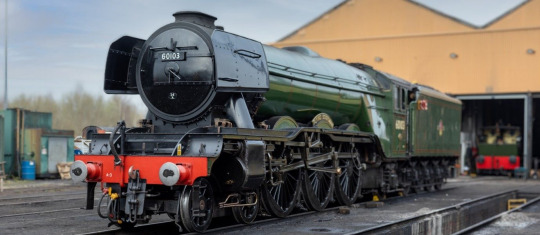
And remember, AEAT certified this engine to run on the mainline. The Flying Scotsman had turned into a literal moving death trap under its various owners, and I am not surprised it cost the NRM £4.2 million to rebuild Flying Scotsman.
In summary, 4472 Flying Scotsman was about as sick as an engine could get when it arrived at the NRM. The amount of work required to fix the poor engine was extensive - and some may argue unjustified. Personally, I disagree. Yes, Flying Scotsman cost a ridiculous amount of money to save and rebuild - but this is not an engine who would ever accept living on a plinth in a museum. This is an engine with a fascinating history filled with trials, tribulations and triumphs; and in my opinion the Flying Scotsman's place is on the mainline. Will there be a day when the old engine has to be withdrawn and placed in the NRM? Probably - it's the oldest mainline certified engine in the UK already, and it's not getting any younger. But by that same token, Flying Scotsman went through a massive, extensive overhaul to ensure that generations to come could see the majestic A3 doing what it always did best, and there's something truly inspiring about that.
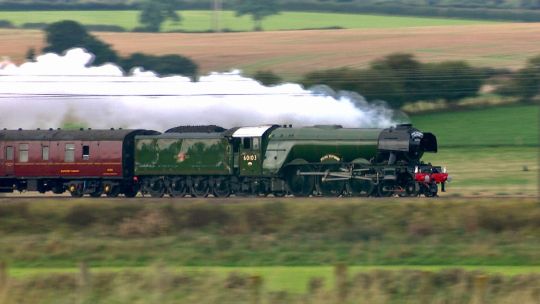
A big thank you to the NRM for saving Flying Scotsman, and an even bigger 'what the hell?' to the people who almost destroyed it by being careless.
The pictures used in this post do not belong to me. All pictures belong to their owners. If you wish to read the NRM Flying Scotsman report yourself, this is the URL, and a hyperlink to its archived form on the Wayback Machine:
#weirdowithaquill#railways#real railway stuff#Flying Scotsman#4472 Flying Scotsman#NRM#The National Railway Museum#Flying Scotsman very nearly didn't get his happy ending#There was a lot wrong#this stuff is crazy#long reads#very long post#lner a3#wayback machine
127 notes
·
View notes
Text
The Conductor's Popper
The Conductor's Popper is a disciplinary railway tool used from the early 1830s to the early 1940s before being banned in 1941 as it was considered abusive and too harsh towards sentient machinery.
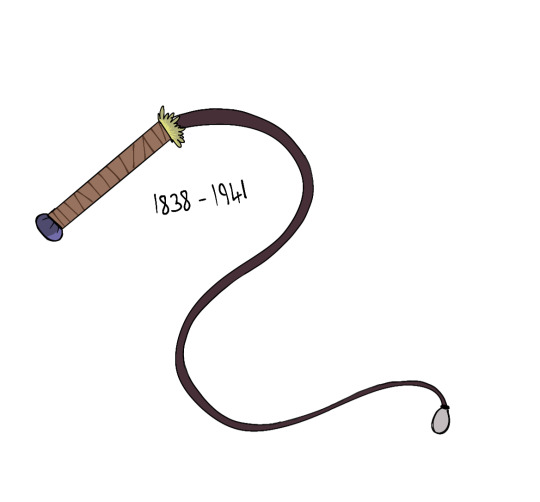
This whip was made in Tywyn, Wales, by railway engineer, Max Macintyre in 1838 as a way to deal with unruly and undisciplined sentient railway vehicles. The whip itself was quite different from standard whips, as instead of a cracking noise, it made popping sounds when used, hence the "Popper" bit in the name. The tool was mostly at use in Wales and was legal to use on engines at the time, though, it found most use when dealing with narrow guage engines.
The whip when in use has enough force to create a 'whip mark' shaped dent in steam engines. Light enough to not fully cut through iron, but was ensured to be strong enough to leave a, as crews heard their engines describe it, "a horrible stinging pain". It started drawing out more concern as time went on, with people debating whether or not it was too cruel or a good disciplinary tool.
A certain railway that once used this type of discipline was the Talyllyn, who used the tool on No 1 and No 2 back in 1865 to 1938. Unlike the rest of the UK, Poppers weren't used on Sodor. As quoted from the NWR Director, Richard Topham Hatt;
"I'm never getting a single one of those cheapskate contraptions to use on my engines. I aim to treat my engines fairly and with respect, not like slaves. If an engine steps out of line, I reprimand them verbally, not physically, I'll even keep them in the shed as punishment if it depends. If I see a single man with a Popper, he'll be sacked the moment I find out!"
This was the same for the Talyllyn's counterpart, the Skarloey Railway.
On the Talyllyn, the engines did not have faces, and in that case were considered blind. Talyllyn and Dolgoch's translators helped them describe what their experiences were like with Poppers. It is up to you to decide if they are truly disciplinary or abusive:
Talyllyn; "When me and Dolly were still young and fresh, the manager and the workers were skittish and unsettled by us. They were used to seeing engines with faces. But unfortunately, me and my sister, along with our friends were cursed by Lady and Proteus alike..."
Dolgoch; "...when an engine, steam or diesel, is built, a face usually appears on their smokebox doors or radiators. For some reason, our faces never appeared, rendering us nearly completely blind and unable to speak through words. We were discriminated by workers, and treated like soulless beings, while our twins were given so much adoration and attention. It made me and Tally a bit jealous, if I must be honest..."
Talyllyn; "...While Sir Hayden Brown was owner of our railway, Mr Max handled operations and observed us. He had one of those nasty whips on him. He'd constantly whip us, or make us hear that popping noise as a warning. Though, he was more short tempered, and while nobody was around, would intimidate or hit me with the Popper. I've got 89 welding marks altogether, some on my boiler and buffers, and a couple on my funnel. Most of them were afflicted on me when I was still a 'bucking bronco'...thankfully, the overhauls and liveries made them fade a bit... most of those marks would just...reappear, even if I got a new, fresh part put on me...I've gotten used to it, it's fine...."
Dolgoch; "...I've got 56 welding marks, a few on my boiler, a few on my buffers and a few near my cab windows. Much like Tally's, they've faded but they're somehow still there. Sometimes, I wish our lives starting out was more like Skarloey and Rheneas's. At least they didn't get whipped if they were being too slow with slate or misbehaving...though, I wouldn't wish our experiences upon them...even despite our sentiments. Thankfully, the Poppers were made illegal by the time Sir Hayden and Edward Thomas arrived...I would dread the thought of young engines having to face discipline like that"
What do you think? Was it right to ban this tool?
(Decided to do a little bit of lore on the ttte version of the Talyllyn railway considering its basically the irl SKR and on a banned weapon used)
#thomas and friends#thomas the tank engine#ttte skarloey#skarloey railway#ttte rheneas#edward thomas#talyllyn railway#talylln#dolgoch#sir hayden#banned disciplinary tool
39 notes
·
View notes
Text
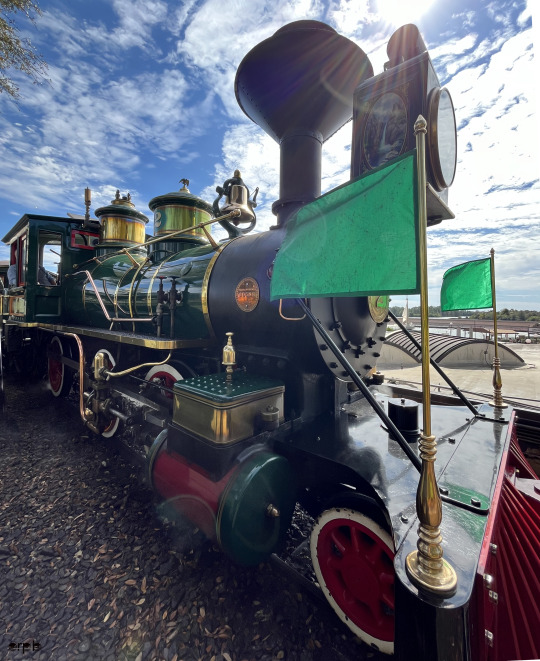
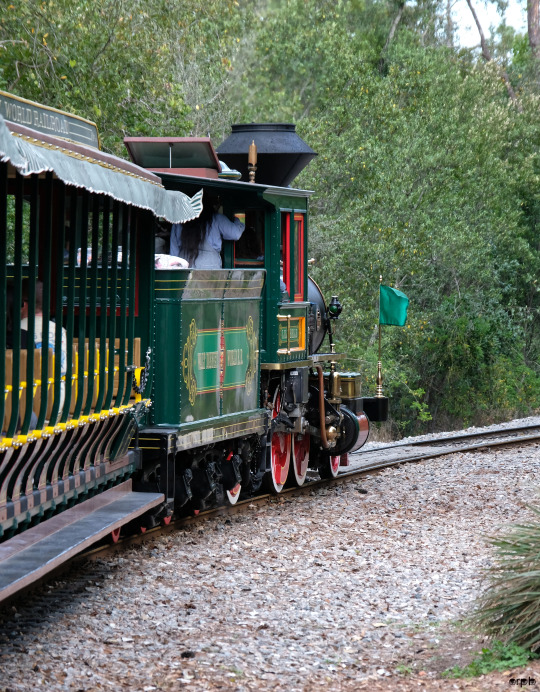

Disney World Railroad – Orlando
(Thema Park Magic Kingdom)
Dampflokomotive - No.2 - Lilly Belle
Die hier fahrenden echten Schmalspur-Dampflokomotiven (Spurbreite 914 mm) wurden gebraucht in Mexiko auf einem Boneyard gekauft und in Florida überholt bzw. umgebaut. Dabei wurden sie von Kohle auf Heizöl umgerüstet, mit neuen Kesseln und neuen Führerhäusern versehen. Auf den originalen Fahrwerken wurden bei den Schlepptendern ebenfalls neue Aufbauten errichtet. Alle vier in Betrieb befindlichen Lokomotiven wurden Lokomotiven von Baldwin Locomotive Works gebaut.
Zu meinem Besuch im Februar 2024 waren nur zwei Maschinen
No.1, “Walter E. Disney”, Achsfolge 4-6-0, Baujahr 1925, Fabriknummer 58444
No.2, “Lilly Belle”, Achsfolge 2-6-0, Baujahr 1928, Fabriknummer 60589
im Parallelbetrieb. Die anderen beiden Lokomotiven
No.3, „Roger E. Broggie“, Achsfolge 4-6-0, Baujahr 1925, Fabriknummer 58445
No.4, „Roy O. Disney“, Achsfolge 4-4-0, Baujahr 1916, Fabriknummer 42915
waren gerade in Wartung.
Disney World Railroad - Orlando
(Magic Kingdom theme park)
Steam locomotive - No.2 - Lilly Belle
The real narrow-gauge steam locomotives running here (gauge 914 mm) were bought second-hand in Mexico at a boneyard and overhauled or rebuilt in Florida. They were converted from coal to fuel oil, fitted with new boilers and new driver's cabs. New bodies were also built on the original bogies of the locomotive tenders. All four locomotives in operation were built by Baldwin Locomotive Works.
At the time of my visit in February 2024, only two machines
No.1, "Walter E. Disney", axle arrangement 4-6-0, year of construction 1925, serial number 58444
No.2, "Lilly Belle", axle arrangement 2-6-0, year of construction 1928, serial number 60589
in parallel operation. The other two locomotives
No.3, "Roger E. Broggie", wheel arrangement 4-6-0, year of construction 1925, serial number 58445
No.4, "Roy O. Disney", axle arrangement 4-4-0, year of construction 1916, serial number 42915
were currently undergoing maintenance.
Translated with DeepL.com (free version)
#dampflokblog.de#Walt Disney Railroad#steam train#railway#dampflok#stoom locomotief#eisenbahn#steam locomotive#Lilly Belle#Baldwin Locomotive Works#Schmalspurbahn#локомотив#lokomotywa#locomotive à vapeur#鉄道#locomotora a vapor#stoomtrein#Steam train#locomotora#locomotive#schmalspurbahn#narrow gauge
45 notes
·
View notes
Video
GCR 9F 92214 por Robert Foster
Por Flickr:
GCR 30742 Photoshoot 26/02/24 Last day of boiler ticket, last steaming before overhaul
15 notes
·
View notes
Text
Something Holy This Way Comes
Ch.13 Alive
Other Stories
Other Chapters
The following morning Enid pushed the flatbed in front of Cassandra while the others watched curiously. Caomhnóir's eyes swirled as the Lady's light shone through her onto the covered object. She slowly increased the intensity, her number one and brass fittings glowing brightly in the dawnlight.
Finally she let the light fade. "That's all they can take." She announced. "They're waking now...Screech if you would?"
Screech reached out a tendril and lifted the tarp slowly away.
A long parallel boiler and an old style cab was revealed, sitting on top of eight 4'3" drivers. Her tender was missing, along with her motion and nameplate. She was covered from funnel to footplate in soot and dirt.
Miss Morgan was up on the engine's bufferbeam before any of the humans had even realized she was moving, brushing away the soot, rust, and dirt out of the engine's eyes as they slowly, weakly opened.
"Water now." She thundered, workmen scrambling to pass her the buckets.
"Miss Morgan?" The engine rasped weakly.
"Easy Hegni." The controller shushed, "you've been without water far too long."
"Hurts."
Screech heard the woman's jaw creak as she grit her teeth, "I know dear."
The men quickly ran a hose from the water tower as Miss Morgan helped Hegni drink the buckets, handing their controller the hose once the last buckets were empty. Other crew were checking over the poor engine, cleaning her as best they could.
As water flowed through her once more, tears began to flow from her striking purple eyes. "Still hurts," she said quietly.
"We'll get you in the works as quick as we can," Miss Morgan swore. She glanced back towards the engines. "Cassandra, Screech, is there anything you can do?"
Cassandra stretched, the Lady's light returning to her eyes again. "If I can channel the Lady's light through Screech it might dampen it enough to keep it from hurting her... but Screech would be taking the brunt of the Lady's power."
Screech shrugged as she extended her tendrils towards Hegni, "If it does not kill me, I have had worse." She laid a set of tendrils gently on the 0-8-0's runningboard. "Ready."
"If it becomes too much for either of you, warn me." Cassandra cautioned. "Miss Morgan..."
The controller reluctantly climbed down and moved to the side
Cassandra's lamp shuttered open and golden light spilled onto Screech, racing up her tendrils like lightning, flowing into Hegni, who began to glow softly.
Dust, soot, and rust began to fall away as the Lady's power flowed and ebbed over the freight engine. Slowly great western green began to reappear from beneath the wear on the 0-8-0.
She eventually shook her head and Screech moved her tendrils.
Hegni took a shuttering breath as Miss Morgan climbed back onto her buffer beam.
"Better?"
"Yes Miss Morgan. It only aches now."
The woman frowned, "I'm afraid that will have to wait till you're overhauled. It would be to much of a risk to push it any further, right Cassandra...Cassandra?"
She turned around to find Screech and Caomhnóir staring at each other, golden light and shadowed tendrils dancing between them.
She raised an eyebrow, "should I be concerned?"
As if in answer, golden light began to make its way across Screech like frost on a window. Power thrummed through the air as the Lady's light ran through Screech.
There was a sound of breaking glass, and Screech let out a strangled growl as a ring of golden light basted outwards from her.
All was quiet for a moment as Screech and Cassandra sagged on their frames, exhausted, their crews rushing over to check on them.
"You did not say you would be hurt as well." Screech rumbled, glaring at Cassandra.
The tank engine huffed a tired laugh, "comes with the job. Besides, I can handle her light better than you...How do you feel?"
Screech shifted her valve gear, which creaked, "It aches, but I believe it will fade, and even if it does not, it is better than the pain."
"What did you two do?" Freda demanded, hands on her hips.
"Cassandra healed her." Mali said, her eyes swirling gold with Cassandra's light. The teen was sitting on Abbey's bufferbeam under a large pile of banquets, as her new connection with Screech had left her shivering and cold to the touch.
"Any side effects on your end?" The tank engine asked.
Mali shook her head, "not really. I don't feel as cold now."
"What do you mean she healed her?" Freda asked as she quickly strode over and began examining the girl while Gywn looked over Screech.
Screech stretched her tendrils experimentally, "she pulled me back into the world of the living."
Everyone froze.
"That's...possible?" Enid asked hesitantly.
"Normally? no." Cassandra said slowly "Pouring enough power to force someone over the line between worlds would erase them."
"It hurt enough as is." Screech admitted.
Cassandra winced, "I did warn you."
"It was worth it." Screech said simply.
"Why could Screech survive it?" Abbey asked as she looked over at Screech worriedly.
"A few things," Cassandra said thoughtfully, "one, she was already immersed in the Lady's power from the fight with the creature. Then she allowed herself to be used as a conduit for the Lady's light to heal Hegni...she was exposed to a massive amount of the Lady's power in a few hours, but none of it was aimed at directly at her."
"So she was already in tune with you anyway." Avon guessed.
"Which meant she could handle a lot more of the Lady without it harming her," Cassandra confirmed. "The other reason, is that she had a living anchor tying her to the world of the living.,
"Me." Mali realized
Cassandra nodded, "I was able to use you to ground her. Having part of her already on this side made it far easier to pull the rest of her over."
"What effect will this have on her?" Abbey asked.
Cassandra tilted her head, listening to something only she could hear, "she will no longer destroy items by touching them, she would have to intentionally focus on causing that. She won't have to furl herself anymore..."
"Thank the Lady for that," Screech purred, looking close to dozing off.
Cassandra smiled at the sight, "since she's no longer having to compress herself to fit within a world she no longer belongs to, it will no longer hurt her to exist here."
Screech rumbled contentedly.
"What's the downside?" Freda asked suspiciously, "there's no way there's not one."
"She's alive again." Cassandra said simply, "or her version of it at least. She can be hurt again, and will suffer wear and tear like any other engine. She needs maintenance and overhauls again."
"Joy." Screech's dry tone was belied by her tendrils swaying lazily around her.
Gywn glanced up at Screech's drowsy expression, "does she need to sleep again?"
"Probably not as much as the rest of us, but yes." Cassandra answered.
"Will being used as an anchor affect Mali?" Megan asked.
Cassandra shrugged, "If anything she'll be affected less now that they both belong to the world of the living. Screech and I took the brunt of the exchange. Some of the Lady's light would have bled over their connection, but not enough to affect permanent change."
"I'm already partly made of her light anyway right?" Mali asked, "You used it to weave us together."
Cassandra nodded slowly, "a very small part, but it is there. Although I doubt it's enough to do anything but hold you together, humans aren't affected by the light the same way engines are."
She glanced over to where Hegni sat on the flatbed, watching with confused interest, "in any case she won't be hit with anymore light anytime soon. I can't channel the Lady anymore without risking damaging myself." She winced as she stretched, "for all that I am her champion, I'm still just an engine at the end of the Day."
Miss Morgan frowned, "I think it's best all of you are looked over at the works. Abbey, grab Screech before she gets any ideas."
A/N: Hey Loves! This ones out a bit early because I have a tropical storm headed my way and I'm worried about losing power. With this installment, Something Hold this was comes is now my longest ever fic by word count. Love Y'all!
#ttte fanfic#rws fanfic#fanfic#U&D#U&DR#Uman and Din#Uman and Din Railway#Eldritch#Eldritch Train#Eldritch Horror#engines that go bump in the night#Ghost Train#Ghost Engine#ttte thomas#ttte Cassandra#Genderfluid Character
9 notes
·
View notes
Text
Steam Test
Written by SodaStupidity

Year: 2023
“Alright sir, he’s ready.”
“Right, lit up his fire.”
With the lit of a match, some shovels of coal, and a turn on the injectors, a comfortable warmth soon spread across the khaki engine. The distinct shape of a Great Western design, with his square firebox and taper boiler. A 2-6-0. His paint and brass fittings glimmering under rays of sunlight peeking through the big airy building, the letters “ROD 5319” painted broadly in white on his tender. The engine slightly opened his eyes, and gave out a rather loud yawn.
“…what year is it?…” the engine quizzed, still waking up from his long nap.
“It’s 2023, you’ve been here for a year and a half under overhaul, Joseph. Looks like you’re good to go.” said a smartly dressed woman, standing next to the sleepy engine.
Joseph snapped out of his lingering slumber completely, he recognized that voice, “Mrs. Walters! Glad to see you again.”
The woman chuckled, “The feeling is mutual, Joseph. I’m sure Betty misses you terribly as well, she will be absolutely thrilled to hear the news.”
Suddenly, a man in overalls peeped out from Joseph’s cab, “Ma’am, he’s ready to go.”
Mrs. Walters nodded, and turned to the khaki engine. “Alright Joseph, before you re-enter service, you’ll be put on a light test train. Just to make sure you’re fit as a fiddle before proper service resumes. All clear?”
“Yes, ma’am.” smiled Joseph. He knows very well about all the checks and exams before he can return to normal life. This ain’t his first overhaul, after all.
“Good engine. Boys, take him out for a spin, will you?” Mrs. Walters called to Joseph’s crew. Then, she turned her head back to the khaki engine, and gently patted his footplate, “Welcome back, Joey.” she said with a smile, and walked away.
Joseph felt the warm steam flowing into his cylinders, and slowly by each wheel turn, he started to move towards the entrance of the workshop. The men near the door pulled it open, revealing the ballast grounds basked in cheerful sunlight, two gleaming ribbons of rails leading into this world he’s oh so familiar with, a large brick built roundhouse laid behind it all.
“Oh yeah, it’s good to be back.” said the Great Western Mogul, as he exited out the workshops of Eastleigh Steam Friends Inc., and into the outside world.
19 notes
·
View notes
Text
Traintober 2023: Out Of Service

Heavy Harry’s Last Train
1956
A sad day for Harry, for he was to pull his final revenue raising train to Melbourne before his overhaul. But the way things were going, everyone doubted if he would actually get it.
He had slept overnight at Seymour before the trip, which was OK because Newport had taken on a charnel house-like atmosphere. The scrap roads filled with exhausted, sad locos ready to be taken apart. It was basically his second home anyway.
Is this the day I finally get to cry? It would be an acceptable excuse to do it.
The tears would not come. He felt drier than the Simpson Desert. Numb.
His cylinders on the other hand, always felt slightly ticklish. And not from those weird happy butterflies he got in them when he saw VR Hudson R700 Nucklevee again, but bad sort of ticklish.
Steam was leaking into them, his regulator was probably broken in addition to his sore, in-need-of-replacement boiler and if it wasn’t for the Westinghouse brake, venting as much steam as he possibly could through his cylinder cocks, safety valve and his sheer willpower in locking them, he would careen off by himself with an 800 tonne load.
He did not want this to happen.
Please, please, please I need my overhaul so bad! Even if you put me in mothballs, at least make me safe!
That’s not going to happen isn’t it?
I’m now an actual danger to myself and people. You can’t really be this negligent, VR? Say it ain’t so? Its one thing to let us get caked in filth, its another thing to lag behind on overhauls just because you want to be rid of us.
You don't care, do you?
I’m about to have my last ride and I’m actively a danger to everyone. I’m trying so very hard…
He was washed and cleaned for his final ride, which didn’t improve his mood a jot but at least he didn’t look as shabby as he did. His paint did shine a little duller though, whether from sadness or from neglect was difficult to tell.
“How are you, Harry…”, asked Driver
“Not great…” he said as if under water.
“I can understand… its a sad day for everyone…”
“I’m shit scared… my regulator is leaking…I can feel the steam in my cylinders even with the regulator shut… I don’t want to do this…”
“Lets try get through today, Har’, we’ll work our darndest to make it safe and get you home...”
“I’m not going to get that overhaul, won’t I…”
“I don’t think so, boy...”
30th of April, 1958
“What are they going to do with me? I’ve been sitting here for two years...I’m bored and antsy… and I haven’t heard from the Historical Society in weeks… Do you have any news, Driver?”
“I’m so sorry, Harry...there’s no nice way of saying this… you are being withdrawn…”
Harry didn’t quite hear Driver say these words, terrible overwhelming fear and confusion flooded his smokebox.
The physical pain that was in his boiler that was now constant but low, suddenly stabbed him and he exhaled sharply.
“No reprieve?”
“No, big fella”
Driver squeezed his knuckle coupling sadly, in an attempt to give him comfort.
“What is to happen to me, Driver…”, he said in a voice that was barely above a murmur.
“We don’t know…the preservationists are working on something… but it will take time…”
That emotional pain that was already there, more of it was being added. But he had to push that aside and think.
“What will you do, Driver…”
“I’m a railwayman, and always have been…
“There’s no place for us in the brave new world of swappable roles they are going to create… easy to drive, easy to train, which was what I suspect was going on the entire time they were doing this diesel introductory thing anyway...
Not a word of thanks for the work and love we put into you and yours, Harry…
I’ll never forget you, big fella…”
Harry wanted so very badly to cry, but the pain could not flow outwards. Instead, it settled back into his cold firebox and burned as bitterness.
The pain in his side flared, as if expressing what he could not.
He just cast his eyes downward and sighed.
There is no light at the end of this tunnel, just another, even bigger fuck-off train ready to barrel through you and out the other side, leaving you in pieces all over the track.
#victorian railways#thomasallgrownup#VR H-Class H220 “Heavy Harry”#Red And Black Steam On Southern Metals#Heavy Harry OC#Traintober 2023#Traintober 2023: Out Of Service
12 notes
·
View notes
Note
Oh, and also how the engines age too. Now tgat i read about Huw (Taly). I forgot to include it in other ask.
okay so !! this is my idea on how engines (and railways) age.
if any of you have watched hetalia (yes i know, you can kill me.) you will probably be familiar with how nations have sort of pseudo immortality. i feel like this idea applies perfectly to the engines and the railways because they themselves are also entities much like nations are in hetalia. like nations, railways get sick when their company is doing bad, and if they get into an incident that may be fatal to an average human, they’ll make it out relatively unscathed.
for engines i think it depends on their condition + how many overhauls they’ve had. i read somewhere that a preserved mainline engine’s average lifespan will have around four to five overhauls, and i think that kind of perfectly describes how they age. the more they work without an overhaul, the more they age.
some exceptions would probably be made for ‘famous’ engines like city of truro, mallard, flying scotsman, etc. these engines are seen more as ‘showpieces’ to me and are more or less celebrities (at least to the engines). they’re under strict care and don’t age like the rest because they hardly (if ever) run anymore. however that leads someone like mallard being a lot weaker than someone like tornado due to mallard being on permanent static display
narrow gauge engines are under stringent care and watch than say the average mainline engine. they may have a longer overhaul lifespan (10 years for a boiler ticket instead of 8). they are also often mothballed (aka put away for a year or so) to keep an entire fleet from being put under overhaul at the same time. they age slower than mainline engines because of this.
6 notes
·
View notes
Text
GWR 4200!
They were a class of 2-8-0Ts.
I usually think of anything eight-coupled as chonksters, but in classic Churchward fashion these fellas have an endearingly gangly look. Thin sidetanks, rounded cab, stringy smokebox support beams...
they're
all neck:

The prototype, No. 4201, was tested for 14 months. It proved successful at the class's intended job: hauling heavy coal trains up and down the South Wales Valleys. The curved terrain and restricted gauge meant that 4201 could carry only a limited amount of coal and water, and the class would come to be nicknamed the "Water Carts" due to their need for frequent stops. Still, they were what was needed for the region's coal trains. In total, 105 were produced, from 1910-1923.
After 1929, coal exports plummeted and a good number of 4200s, when sent to Swindon for overhaul, were instead put into store. In 1937, 14 of these stored engines were rebuilt into Class 7200 2-8-2Ts. The trailing wheels allowed for increased water and coal capacity and the new 7200s found work throughout the GWR system.
The class was withdrawn between 1959-1965. At the end of Western Region steam in 1965, 18 were still in service.
5 are preserved, all of them Barry rescues. Of note: 4270's boiler ticket is good until 2024 and it is working on the Gloucestershire Warwickshire Railwy. 4248 is a static museum exhibit, displayed dismantled as if it were "in Swindon Works" (oof!) 4277, currently under overhaul, has been given the name Hercules by its owner, the Dartmouth Steam Railway.
26 notes
·
View notes
Text
The Two Good Fairies (Wait, Two?)
Just a bit (a lot) of re-imagining of the finer details of Duke's rescue and the episode Sleeping Beauty. I haven't exactly posted my writing publicly before so don't expect stellar content lol. I also took some liberties between the tv series and RWS canon, but most of the inspiration is from the tv series. Also crediting @/ryan1014n2 for the aluminum works HC for Stuart and Falcon!
“...and that’s why they call you a hotbox!”
“Hotbox?! At least I’m not the one with steamroller wheels!”
Rheneas watched the two new engines bicker with amusement as he waited for his own departure, passengers still slowly filing into the coaches attached to his back buffers. The two new engines, Sir Handel and Peter Sam were double-heading a heavy freight train, passing by the station slowly.
“Steamroller! Wait until Duke hears about this one!”
Sir Handel proclaimed, and the bickering had all but stopped. Rheneas couldn’t see the expression on either engine, they had already passed the station by then, and were speeding along the line once more.
A familiar whistle sounded across the platform, Rheneas whistled back as Skarloey pulled into the station.
“Rheneas! How does it feel to be back on the line?”
“Just wonderful, is that even a question? I was so glad to finally get overhauled, but I’m even more grateful to be back.”
The two old engines shared a laugh, before settling into the buzz of the busy station. Tidbits of the earlier conversation between the two new engines resurfaced in Rheneas’ mind.
“Say, Skarloey. You know that Duke person that Sir Handel and Peter Sam bring up? Who are they?”
The red engine froze, before returning Rheneas’ gaze, a hint of bitterness in his eyes.
“Duke is…an engine. He was on the old railway that Sir Handel and Peter Sam used to run. It closed after some time and…they couldn’t find Duke a new home.”
Rheneas felt dread pool at the bottom of his boiler.
“Was he…”
“Oh, no, they didn’t scrap him. They just…sheeted him. But who knows what happened to the poor old engine?”
Rheneas opened his mouth to reply, but the sound of guard’s whistle kept the words on his tongue. Pursing his lips, Rheneas simply whistled back as he pulled out of the station, left to ponder about this mysterious engine’s fate.
~~~~~~~~~~~~~~~~~~~~~~~~~~~~~~~~~~~~~~~~~~
Several years had passed since their conversation, and Rheneas would have forgotten, if he didn’t hear passing mentions of Duke whenever the two new engines were around.
No, calling them new would imply they were strangers, Peter Sam and Sir Handel had far outgrown that title.
Sometimes, when the rain was heavy and the trees rustled against the brick of their sheds, the two engines would recount tales on their old railway. It was from these stories that Rheneas and Skarloey would learn more about the mysterious engine named Duke.
Duke, or as Sir Handel and Peter Sam liked to call him, Granpuff, was the old faithful of their old railway the Mid-Sodor. When they were still called Stuart and Falcon, Duke was the one to keep them in check and out of trouble. They talked of the time that Duke gallantly pulled Sir Handel back up the mountain, or the time Duke humbled Peter Sam by roaring loudly on the mountain as though he were the one with a packed passenger train and an engine pulling on his coupling. The two told of many stories, some more savoury than the others, but not once had they spoken Duke’s name without love.
And, as Rheneas would later recognize in their voice, grief.
One day, after returning to the sheds for the night, with Skarloey being the only other engine present, Sir Topham Hatt approached Rheneas and Skarloey along with a group of men holding rolls of paper and small suitcases.
“Starting from tomorrow,” announced Sir Topham Hatt, “I’d like the two of you to assist in a special job,” and he quietly explained to the two old engines the visitors’ proposal.
“They want to find Duke!” Skarloey exclaimed as the men left with the Fat Controller, “Goodness! Wait until Sir Handel and Peter Sam hear about this, they’ll be ecstatic!”
But Rheneas shushed his brother, “Best keep it a secret until we actually do find him,” he replied, “It would be such a letdown for them if we build up all this hope only to end up finding nothing.”
And so, the two engines and their crew agreed to keep this operation a secret. In the following days, either Rheneas or Skarloey would take the visitors and some workmen into the faraway mountains, going through old tunnels and over high bridges, trying to find the old shed that still housed the lost Duke. Every day, they would go deeper and deeper into the hills, and with each day their hope dwindled, but the search carried on, the crew refusing to give up.
Skarloey waited on the old rails, watching as the search crew climbed further and further into the old station, looking like ants as they scrambled over the overgrown ruins. Bored, Skarloey observed the mountains around him.
From the moss-covered tracks to the rusted barrels and rotting wooden crates that strewn about the grounds paved with gravel, Skarloey’s gaze trailed to the empty decaying shed, the first thing they had found upon arriving. Pieces of the roof had broken off and fallen onto the ground, the glass on the windows cracked and filled with holes, and vegetation ate away at the bricks and wood that still struggled to keep the shed intact.
Skarloey’s observations were interrupted by the sound of a distant crash. Returning his attention to the search crew, they were rushing towards the top of a particularly shallow cliff. Skarloey squinted his eyes. Was that…smoke?
The men crowded around the clouds of dust, and Skarloey was too far away to hear their conversations, but soon cheers and laughter erupted from the crew.
“We found him! We found our sleeping beauty!”
~~~~~~~~~~~~~~~~~~~~~~~~~~~~~~~~~~~~~~~~~~
Skarloey and Rheneas waited patiently as the crew secured the old engine to the flatbed, chains pulling over the engine’s dusty, worn brown paint. Some of the men discussed among themselves what to do with the decade-old coal that still remained in the old engine’s little tender, but neither Skarloey nor Rheneas caught the end of that conversation as their crew prepared for departure.
Rolling along the old track, Skarloey was coupled up to the flatbed, curiously observing the old engine they had just rescued. Duke’s eyes were wide and filled with glee as he watched the mountains pass. Soon, the old engine’s gaze landed on Skarloey.
“Oh? Hello there, I don’t believe we’ve met before,” Duke inquired of Skarloey.
“No, we haven’t. But I’ve heard a lot about you,” Skarloey replied, and the two began chatting, with Rheneas soon joining in from behind. They talked of the stories that Peter sam and Sir Handel would tell, now hearing Duke’s perspective as well, chuckling over how the two had been such cheeky engines in their youth.
“Really now? Seems like Peter Sam hasn’t changed a bit!” Rheneas retorted, and the three laughed once again, though a sadness settled in Duke’s tired eyes.
“Peter Sam, is it? Everything does change, I suppose.” The old engine murmured solemnly.
“Perhaps, but I’d say the joy I hear in their voices when they told your stories was all genuine, and so was the sadness they'd tried to hide,” Skarloey said in return.
Duke contemplated Skarloey’s words in silence as they passed over the viaduct. With his gaze trained on the ravine below, Duke smiled tenderly.
~~~~~~~~~~~~~~~~~~~~~~~~~~~~~~~~~~~~~~~~~~
Sir Handel bit back a retort, imagining all the ways he would one-up Peter Sam once given the chance. As he waited for his coaches to be uncoupled, Skarloey rolled into the station, strangely muddy for a day at the quarry and barely contained excitement.
“Hello Skarloey, what’s got you all excited?” quizzed Sir Handel.
“Oh, has the Fat Controller not told you yet? There’s a surprise waiting for you and Peter Sam at the sheds!”
“Surprise? How nice of him! What is it?” Peter Sam replied.
“Well, I’m not one to spoil surprises, but there’s someone you’ve been longing to see, just as he’d been longing to see you again.”
…huh?
“You mean…Duke?”
Skarloey’s grin widened. Next to him, Peter Sam bounced about on his tracks, shaking with joy, but Sir Handel remained frozen on his spot, disbelief still rampant in his mind. Distantly, he could hear his driver’s comments about his fire going on and off, unstable and incapable of producing good steam. Skarloey spoke again, but his words faded into a buzz, settling into the background with the rest of the bustling passengers at the station.
…
Glimpses of the mountain cliffs flashed through his mind, the pull of gravity on his buffers and the drafts of wind from the bottom of the mountain, the sheer cry of the eagle that pierced through the screeching and humming of his Granpuff’s wheels as he pulled and pulled against the tracks. Then, the comfort of the ground, of being pushed back to the station, standing safely next to his Granpuff as he shushed him to sleep later that night with a rare softness to his gruff voice.
…el…
Then there was the bitterness, the painful panging in his boiler when their old railway closed. The gut-wrenching fear, clawing and clambering at him as he was driven away from his Granpuff, who stood faithfully to the very end at his shed at the foot of the mountain.
…alco…
Short flashes of those brief years at Peel Godred, the coldness of the factories where he found his only comfort next to his brother, wishing and hoping everyday that maybe, just maybe, someone would be nice enough to bring their Granpuff back.
Drip. Drip.
Wishing, praying, oh he’d have done just about anything to have his Granpuff back, if only just for one day-
“Falcon!”
Sir Handel was snapped out of his thoughts, Peter Sam had stopped just before his buffers, with Skarloey looking on from the side with concern.
“...Stuart?”
Tears welling in the corners of Sir Handel’s eyes splashed onto his footplate, only then did he notice how blurry his vision had gone, muddled by emotion. Blinking rapidly, Falcon cleared his eyes and took a good look at his brother before him, just to make sure he didn’t mishear.
It was like they were back at the aluminum works, where Stuart would feign bravery and act strong for both of them, keeping a smile on his face as he pushed on. But Falcon always saw the fear in his brother’s gaze, the trembling young engine who just wanted to be comforted too, but had put on a brave face because one of them had to.
Now, wearing the same expression that Stuart had on when he tried to calm Falcon down the same way their Granpuff used to, there was still a fear that had long since lodged itself within him, but there was also something new. Like their very first night at Peel Godred, Peter Sam had hope, and maybe just a little bit of his own tears.
“Come on, Falcon, looks like we have to keep Granpuff in check.”
For one last time, Sir Handel dared himself to spare a glance at Skarloey. The old engine, now joined by Rheneas, smiled at him assuredly. Squeezing out all his remaining tears, Sir Handel beamed at Peter Sam.
“Yeah, gotta keep Granpuff in order, Stuart.”
#ehe#i hope this wasn't too cringey LMAOO#but yeah i. read a realllly juicy fic on ao3 and it got my hamster brain running#i wrote this in like 6 hours so#some of the train stuff probably isn't gonna make sense because im not a train geek but i tried-#all the lab report and mock journal writing accumulated to this!!!!#ttte sir handel#ttte peter sam#ttte skarloey#ttte rheneas#ttte duke#ttte#ttte fanfic#stem major tries out media literacy#capy posting
49 notes
·
View notes
Text
Been on an A1/A3 kick as of late, and 'Grande Parade' has drawn my interest
The original 2744 was built in 1928, entering service in August. She had 9 and a bit years of incident-free service until the Castlecary Rail Disaster, 10th December 1937. Going light on the details of the event for the purposes of this post, but the damage to 2744 was sufficient for Doncaster to just build a whole new engine.
Ouch.
The replacement (scroll to Works Visits or Summary for the mention) fared rather better, lasting through to BR days racking up 25 years and 7 months of service.
See also: The locomotive was recovered and taken to Cowlairs Works where it took some time to restore it to a condition in which it could be towed to Doncaster. The January 1938 Railway Observer reported that work had begun on the erection of a replacement locomotive at Doncaster, although the remains of the original were still at Cowlairs. From an accounting perspective this was a “repair” of the original but in practice it was a completely new locomotive assembled largely from stock components. The locomotive emerged from Doncaster Works on 14th April 1938 carrying a boiler that had last seen use on A3 2544 “Lemberg” whilst the tender had last been attached to A1 2579 “Dick Turpin”. The June 1938 Railway Observer states that new motion, stamped “2744”, had been provided and that the works plate fitted to the replacement locomotive, proclaimed it to be Doncaster 1694 of 1928.
The original locomotive reached Doncaster on 2nd April 1938 where it was dismantled with anything reusable going into the pool of spare parts. The boiler was overhauled and subsequently emerged fitted to A3 2749 “Flamingo” during its next works visit whilst the tender eventually emerged from the works attached to A3 2752 “Spion Kop”. (Also a bit of a scroll there so just copied the relevant bit)
Considering what the RWS interpretation of that would be, cause like. Henry.
I've got my own headcanon for henhouse, but this is rather different as it's literally stated to be a replacement. They started a new one before the original was brought back.
Just kinda wondering there as to whether you could say something of the 1928 engine went across, what with the Works Plates being the same and all, or if the on-paper-repair-but-actually-brand-new thing would put it in the more literal variant of the "Two Henry's" thing.
In the latter case, how would the other A1s & A3s take it? How would the new engine themself handle it?
Discuss
#LNER A1/A3#rws oc: grande parade#LNER 2744 Grande Parade#also just wanna note here her number's the reverse of Scotsman's#just a neat thing i noticed#there's potential for a lot of angst here isn't there#messed around with this post a few times in drafts#so sorry if it doesn't exactly flow#but i found some new info when it was basically a whole other post#kinda like the engine in question heh
5 notes
·
View notes
Text
Traintober 2023: Day 1 - Free Day
Preservation on Sodor:
Sodor must be one of the most interesting places to look at when it comes to railway preservation, if not also road, sea and air preservation. For starters, the island’s railways are all still primarily run by vintage steam traction – but there’s also Harold, who is in his 60s or 70s at this point, Bertie the bus (who is nearing 100), Trevor and Terrence and George – not to mention the fact that the island seems to continue to have antique ships within its waters, including steam ships and fishing trawlers.
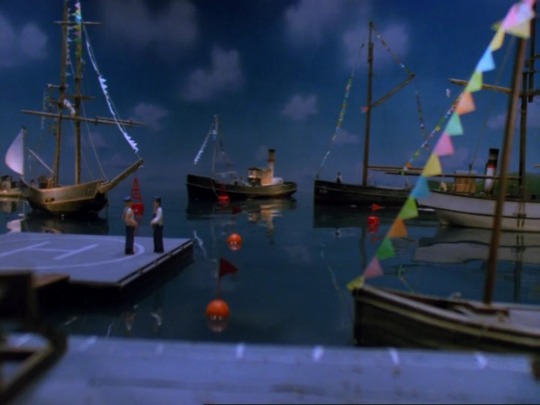
But of course, I want to focus on the railways – and in particular how Sodor must be the British hub for heritage railways, museums and other attractions. For starters, Sodor has by far the largest heritage railway system in the world for its size, with over 80 miles of mainline, several branchlines, a narrow-gauge railway, a mountain railway and a miniature gauge railway. It also has a massive fleet of engines – 80 by the Reverend’s count on the NWR alone – making it possibly the single largest working heritage railway in the UK, if not Europe. This would instantly attract many preservationists wishing to run their locomotives, meaning that mainline excursions and visitors would be a frequent sight on the island. This in turn would bring in tourists, who would make money for the NWR and the railway the engines belong to, as well as helping the Fat Controller if one of his enignes is unable to work. It would also give us as railfans the chance to see unique motive power on a variety of trains - like a Coronation Class pulling a slow goods, or a Hughes Crab on a China Clay train - things we don't get to see anymore.

Furthermore, Sodor is home to Crovan’s Gate Works, the largest steamworks of its kind in Britain. For its influence, I am going to turn to 60163 Tornado. When Tornado was built, her boiler had to be manufactured in Germany because there was just no one in the UK able to produce a boiler of the type, while the superheater header needed to be attempted by three foundries before it was assembled correctly. Crovan’s Gate Works, which is able to maintain a full fleet of engines including Gordon – who is also an A1 with many similarities – would have been able to do both in a far timelier manner. The same would go for all locomotive repair programs in the UK. Crovan’s Gate would either host locomotives or manufacture parts for them, becoming a hub for preservation across the country. Engines like Stepney or Green Arrow would be able to be overhauled at the Works, rather than be taken out of service. This would effect how many steam engines are in working order in Britain, if not Europe, as the refurbishment time would be significantly shortened - something that is compounded if said locomotive shares any components with a Sodor engine - like Talyllyn, Dolgoch, Flying Scotsman or any of the Black 5s, Panniers or Autotanks in preservation.
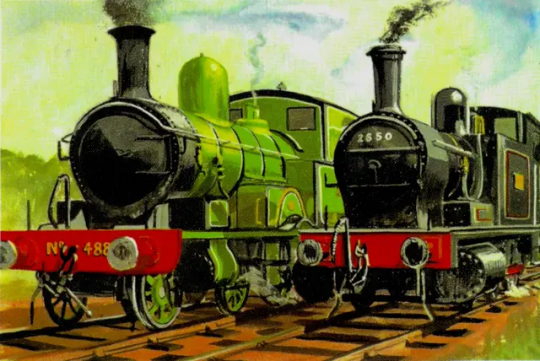
This brings me on to the last point: International Tourism. Sodor must be one of the most visited locations in Britain in this universe. For starters, there’s all the fans of the book and TV series (which are both canon and referenced in the books). This means that Sodor would have tens of thousands of families coming to the island from around the world annually to see the ‘Eight Famous Engines’ or the ‘Steam Team’, bringing in a massive amount of revenue for hotels, local businesses and the railways themselves. But there would also be the railfans who come with the aforementioned railtours, as well as international railfans who want to see steam in action in a mainline setting – something nearly impossible anywhere on the planet. Sodor has at least one airport (and probably two, considering in real life there is an airport on Walney Island near the real-life Vickerstown), six ports connected to the NWR, and a rail and road link to the UK. The island has the infrastructure to handle the flocks of tourists, and this would in turn benefit much of the rest of Northern England. This would majorly benefit the preservation world by bringing in funding for Sodor, which is in turn able to fund things like track upgrades, or overhauls for engines beyond their own railway. It also gives other railways a good place to promote themselves, as Sodor has a guaranteed market for tourists who may travel to these other railways.

You cannot understate how much these books have done for Sodor, and for railway preservation as a whole.
So, Sodor is at the very least a centre for preservation in the UK, with railtours, overhauls and masses of international tourists – but it’s also where a lot of engines were likely rescued from. We see it in Oliver and Douglas, but engines know of Sodor and its safety. I can imagine an alternate universe in which engines keep turning up throughout the 1960s, being brought to safety on Sodor and then sold to heritage railways, being overhauled at Crovan’s Gate before moving to their new homes. Sodor would act as an intermediate in this era, being able to do the paperwork to preserve engines due to its position in the national network while also being aligned with the cause of the heritage railways. Sodor is a safe haven for steam, and this would have a significant impact on its position as a preservation hub for the UK.
Back to the Master Post
#railway series#weirdowithaquill#thomas the tank engine#railways#traintober 2023#railway preservation#rambles
104 notes
·
View notes
Text
I am in the midst of a house move. It is not by choice. I am one of the thousands of renters in London facing eviction – although technically our landlord has simply decided not to renew our tenancy, a decision that doesn’t seem to factor into official eviction stats, though it should, given the frequency with which it’s occurring.
My landlord was one of that rare breed: the “good” landlords. You hear about them occasionally. The bar is very low, yet most private landlords (in London, at least) fail to clear it. Not a price gouger; fixes things when asked; doesn’t treat tenants like squatters who happen to be paying half their monthly salary for the privilege of residing in their buy-to-let.
But without proper legal protections and rights for private tenants, such as rent caps, tenancy security even in cases of house sales, and the option of indefinite tenancies, all that separates a good landlord from a bad one is the wafer-thin concept of decency. Tenants are totally reliant on the whims and personal circumstances of their particular landlord. As such, privately renting is not just a financial and psychological burden: it is also a crash course in extensive relationship management.
See: putting off getting the boiler fixed because the washing machine was just replaced, and if you ask your landlord for two costly repairs in a row a little switch in their brain might flip your house from “asset” to “albatross”, and they might decide to sell. Or calling a house meeting to collectively draft an unfathomably sycophantic email two months before your contract renewal essentially begging the landlord to grant you and your housemates the great honour of staying in their beautiful property. Sending them flowers, just because. (There is a housing crisis, and you need them to like you enough to ignore the estate agent in their ear telling them they can collect 30% more in monthly rent.)
And yet, at the slightest pressure decency withers and dies. In September, my “good” landlord asked to increase the rent by a small and reasonable amount, in line with rising living costs (no word, of course, about decreasing the rate to mirror real-terms pay cuts). My housemates and I agreed, but requested the increase came into effect after 90 days, according to the terms of the contract we had signed, rather than immediately. The landlord pushed back, with an undertone of aggrievement that we would repay their kindness in such a fashion, and then went quiet. Days later, we were informed our tenancy was ending. By adhering to the only legal protection we had, we’d become an albatross.
Unspoken was the reality that by referencing the vulgar, transactional nature of the landlord/tenant relationship, we had pierced the gossamer veneer of civility. We had reminded our landlord that they were a landlord, and not simply a kind benefactor. It was ungrateful in the face of their generosity. Personal affront sealed our fate.
Where the state has withdrawn, I have noticed an increasing emphasis on interpersonal “decency” to one another, an exhortation to rely on a supposed inherent goodness that will see us all done right by. Perhaps the seeds of this rhetoric were first planted by David Cameron’s vision of a “big society”, which involved the cutting down of actual society, via slashed public spending, and its replacement with voluntarism. There is a cultural emphasis on being “kind” in lieu of solid legislative frameworks and state safety nets to catch us when we fall.
Often, it is those people with the most material power who preach this doctrine: at the height of the Covid-19 pandemic, the then chancellor, Rishi Sunak, was instructing the public to practise “kindness” and “decency”, and later refusing to overhaul statutory sick pay. Wealthy celebrities and influencers wield the phrase “Be kind” like a get-out-of-jail-free card at the slightest hint of criticism. And there is a reliance on the individual compassion of the likes of landlords, in order to keep a roof over our heads. This “kindness” is a myth: it is bondage of a feudal nature, an exercise in massaging the egos – or should that be the consciences? – of those with assets and access in the hope that they will continue to patronise the rest of us.
Unfortunately, this vague folk concept of “kindness” disappears as soon as those at the top of the totem pole feel a squeeze; see landlords en masse increasing rental rates in line with their own living costs, never mind that some aren’t even grappling with higher mortgage repayments and have more than enough of a financial cushion from the properties they let out.
It is understandable in times of crisis: a scarcity mindset becomes particularly sharp. The perception of being harder up, however, means kindness falls by the wayside. Self-preservation kicks in, and damn objectivity when it comes to assessing actual power dynamics.
“It’s been a very difficult time for landlords, too,” my friend was told earlier this year, after a rent increase on her mouse-infested flat. The landlord in question collects income from 11 properties. Under the decency doctrine, everyone’s suffering is equal.
Keep your kindness. I would rather have housing security or the ability to easily book a GP appointment without relying on a sympathetic receptionist’s pity when I turn up at the surgery in tears at 8am. “Decency” without the backing of robust welfare and legislative infrastructure is nothing but a farce, existing to alleviate the guilt of the haves in relation to the have-nots. It is a finite resource. The UK, it seems, is close to running on empty.
31 notes
·
View notes
Text


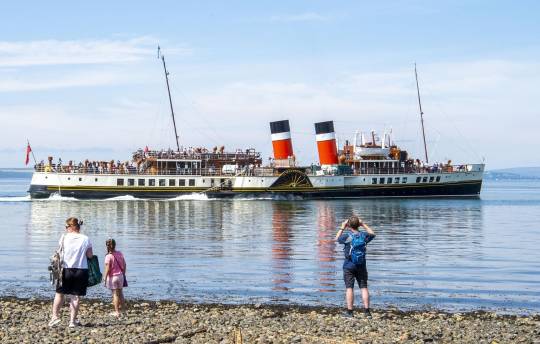

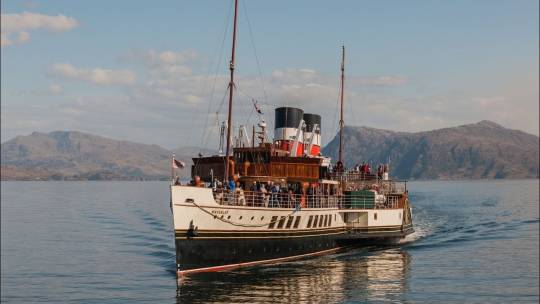
On October 2nd 1947 the paddle steamer Waverley was launched from A. & J. Inglis’s yard on the Clyde.
The Waverley is now the last sea-going passenger paddle steamer anywhere in the world. She was named after the debut novel of Sir Walter Scott, but wasn’t the first paddle steamer to bear the name. The previous Waverley, built in 1899, had been requisitioned as a minesweeper during World War II and sank during the Dunkirk evacuation in 1940.
Materials were so scarce in post-war Britain that the new Waverley had to wait more than three months after her launch to have the boiler and engines installed. She finally entered service in June 1947, sailing a scenic route up Loch Long to Arrochar.
Ownership of the Waverley passed to the Caledonian Steam Packet Company in 1948. Between 1949 and 1964 she had a variety of winter duties, often replacing another ship that was being overhauled, or she was the spare vessel ready to cover for others in an emergency. In the main season, her routes were extended to include the Isle of Arran in 1953 and from 1958 onwards, there was also a cruise up the Clyde to Glasgow. By 1970, she was the last seagoing paddle steamer in the world. By 1971, Waverley was one of only two large excursion vessels left on the Clyde and was based at Gourock. In 1973, CSP became part of Caledonian MacBrayne Ltd
Waverley was sold on 8 August 1974 to the Paddle Steamer Preservation Society and refitted for the Waverley Steam Navigation Company. In 1975, she re-entered service on the Clyde, sailing at weekends from Glasgow and in mid-week from Ayr. In 1977, she spent a week on excurisions from Liverpool and the success of this led to over a month being spent on the South Coast in the following year. In 1981, she was fitted with a new boiler and embarked on her first full season of Round Britain cruising, with the peak summer weeks spent back on the Clyde.
In her 1990/91 winter refit, the paddle wheels were replaced and a major £7m two-stage rebuild was undertaken in early 2000 and winter 2002/03 in Great Yarmouth with the support of the National Heritage Lottery Fund. Waverley continues to be maintained in excellent condition and is the last seagoing paddle steamer in the world, fully restored and painted in her original LNER colours. She now runs cruises and charter days out around the British Isles and in 2015 celebrated 40 years of service under her current owner.
6 notes
·
View notes
Video
1015. 92214 NYMR 28.09.13 por Mike Brook
Por Flickr:
An immaculate BR Standard Class 9F 2-10-0 No. 92214 'Cock o' The North', making its first Gala appearance after its recently completed 'fast-track' 10 year boiler overhaul, continues to power up the steep 1 in 49 Esk Valley Gradient, while hauling the 15.30 service from Grosmont to Pickering, during the NYMR 40th Anniversary Autumn Steam Gala on Saturday 28th September 2013
14 notes
·
View notes